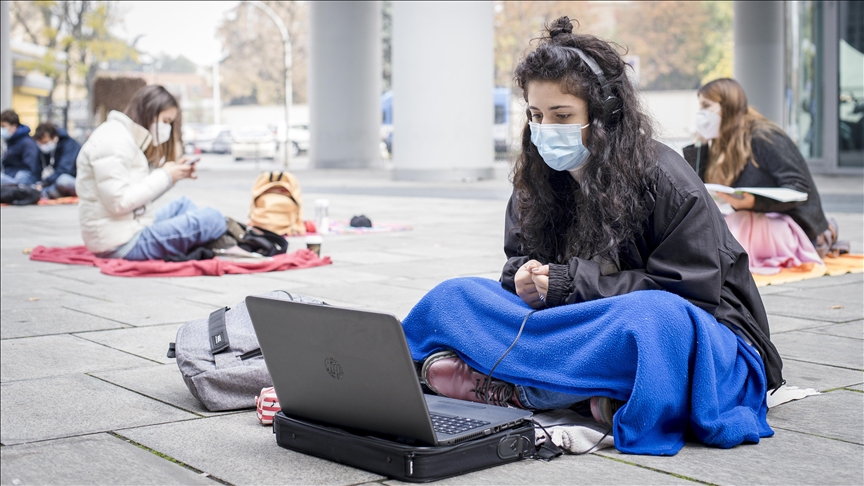Students, parents fight school closures in Italy
Protests rise across country as long shutdown due to pandemic fuels social divides
 Studenti Presenti
Studenti Presenti
ROME
Italy has been the country that closed its schools longer than any other in Europe in a desperate bid to contain the first wave of the coronavirus pandemic.
Now, as it battles a second wave, many parents and students fear it will be the last to reopen.
As classes resumed in mid-September following a six-month hiatus, the second wave of COVID-19 infections caught authorities completely off guard.
When the curve of contagion spiked again in October, middle and high schools were shut down across Italy, switching again to distance learning.
In recent weeks, students, teachers, and parents took to the streets from north to south -- in Milan, Turin, Rome, and Naples -- calling for an immediate reopening, possibly ahead of the Christmas holidays.
But according to the latest government decision, a quarter of Italian high school students will continue to study online also in January, and only 75% of them will be able to go back to classes starting on Jan. 7.
Luca Biscuola, 17, is the founder of the movement Studenti Presenti (Present Students) in the northern city of Milan -- one of the hardest hit by both waves of the pandemic. Along with hundreds of other high school students, he is asking local authorities to allow them to go back to school “in presence” as soon as possible.
“We sit down once a week with our PCs and tablets in front of the region’s building and we follow our lessons from there,” he told Anadolu Agency. “But we are not just protesting, we are making proposals.”
Both students and parents complain that over six months, older pupils were in class no more than 20 days, with no opportunities to catch up during the summer. Central and local authorities did not organize any rostering system able to bring students back to school amid strict safety rules.
The reorganization of public transportation -- one of the main hurdles to reopening -- remained a mirage, as only one-third of the €300 million (over $363 million) in funds available was invested in reinforcing local transport.
No tracing system based on swabs or rapid tests was made available inside schools, making it impossible to track or check positive students as they went back to class.
Emotional damage
The cultural damage of keeping kids isolated for so long is paired with the emotional one, parents warned.
Lisa Jucca -- the mother of a 12-year-old student who returned to middle school in November -- is a co-founder of an activist group named “A scuola!” (At school!), which stages a silent protest every day in front of Milan’s City Council.
“My daughter was happy to return to class. During the lockdown, I noticed that she didn’t want to go out anymore, she had lost her enthusiasm,” Jucca said. “School is the main aggregation hub for youths.”
Experts noted that kids and teenagers showed growing symptoms of depression and anxiety after the long quarantine imposed by central governments across Europe to block the spread of the virus.
A recent study published by the Journal of the American Academy of Child and Adolescent Psychiatry analyzed the effects of isolation, loneliness, and mental health on children and youths aged between 4 and 21.
The results showed that they risk developing depression three times more than adults following the “social block” caused by the pandemic. The effects of this forced period of isolation may last up to nine years.
Both teachers and students are alarmed by the fact that the government has focused on restarting Italy’s ailing economy -- reopening shops and shopping malls in December -- while leaving schools behind.
“School should be on top of everything, together with health,” said Anna Boatti, a teacher of Italian and Latin languages at Milan’s Liceo Virgilio. She has been seeing her students only on a computer screen for months now.
“I miss the third dimension,” she added. “I can’t see their eyes, I can’t understand if I get their attention. How can we expect to attract interest from a teenager remotely?”
Lost generation
Parents also noted that closing schools hit the most fragile among students, both from a social and psychological point of view.
“We are putting at stake the future of this country, not only education but also these kids’ balance,” said Mario Pau, father of a 16-year-old high school student and also a member of A scuola!

“The damage is even bigger for fragile students: kids with disabilities who need physical contact need to be embraced,” he added.
Distance learning widened the technology gap between families that have wireless and fast internet connections and others that do not even own a computer.
Official data showed that social and health differences emerged strongly during the pandemic. Among the most disadvantaged were the 800,000 first-generation students born from foreign parents, along with about 269,000 disabled students, and 276,000 with specific learning disorders.
Online schooling also aggravated Italy’s already existing high school dispersion rate: with the use of distant learning, in about 18% of schools, 10% of students were absent on a regular basis.
Students also bear the brunt of being potentially responsible for the spread of the virus. After schools reopened in September, the infection curve started rising again. But there is no scientific data able to prove that schools were the source of this second wave.
“We ensured health security inside classes by using protective masks and thermic scanners, with teachers and staff active in protecting students,” Boatti said.
“The government, instead, had no real plan,” she added. “The idea is that if infections surge again, schools will simply be closed again. That’s a shame.”
*Photos by Studenti Presenti
Anadolu Agency website contains only a portion of the news stories offered to subscribers in the AA News Broadcasting System (HAS), and in summarized form. Please contact us for subscription options.








